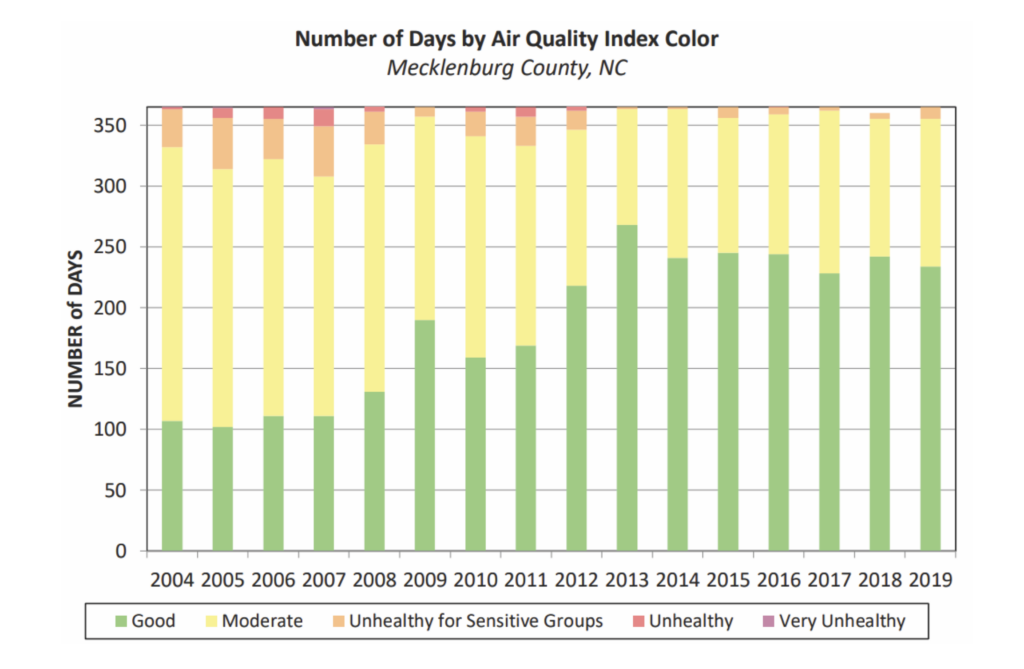How Charlotte’s Strategic Mobility Plan could benefit air and water quality

(Photo: Nabeel Syed on Unsplash)
This is Part 2 in a series highlighting how Charlotte’s new Strategic Mobility Plan could benefit the three E’s: the environment, equity, and economy. In this post, we’ll be wrapping up our discussion on the environment, focusing on how the plan could protect Charlotte’s air and water quality.
This is Part 2 in a series highlighting how Charlotte’s new Strategic Mobility Plan could benefit the three E’s: the environment, equity, and economy. In this post, we’ll be wrapping up our discussion on the environment, focusing on how the plan could protect Charlotte’s air and water quality.
Catch up on Part 1– which covers how the Strategic Mobility Plan could reduce our greenhouse gas emissions and help Charlotte grow more sustainably– here.
Climate change is not the only environmental challenge Charlotte faces
Charlotte is a car-dependent city, with 76% of people commuting to and from work alone in their cars. As we covered in Part 1, driving so much increases greenhouse gas emissions, which build up in the atmosphere and contribute to climate change. A crucial goal of the Strategic Mobility Plan is to reduce the share of people driving alone to work to 50% by 2040.
Climate change poses a serious threat to Charlotte, but it’s not the only environmental challenge we’ll be facing if we keep driving too much. Tailpipe emissions and auto fluids can pollute our air and waterways, directly harming our environment and our health.
What comes out of your tailpipe is a major contributor to air pollution
Cars are one of the biggest contributors to poor air quality, producing about a third of all air pollution in the U.S. Car exhaust contains a wide range of gasses and particles that contribute to smog and poor air quality. Here are a few of the major pollutants that could be coming out of your tailpipe:
- Carbon monoxide – an odorless gas that impairs the flow of oxygen to the heart and brain at high concentrations. The transportation sector is one of the main sources of outdoor carbon monoxide, which can be dangerous for people with heart conditions at high levels outside.
- Fine particulate matter – a mixture of microscopic solids or liquid droplets, which can include heavy metals and air toxics that affect your lungs and heart. Fine particles are the main cause of haze and can be carried long distances by wind to settle on ground or water.
- Nitrogen oxides – a group of highly reactive gasses that can irritate the respiratory system. They react with other chemicals in the air to form particulate matter, acid rain, and ground-level ozone.
Good air quality is important for you and the environment
When it accumulates in high enough concentrations, air pollution can be harmful, worsening existing health conditions and causing disease. According to the World Health Organization, an estimated 7 million people die each year from air pollution.
Animals, plants, and even entire ecosystems also suffer from the effects of air pollution. Pollution particles in the air fall back to the earth, killing plants and crops by contaminating soil and water. Acid rain depletes soil nutrients and affects water quality. And like humans, animals can experience birth defects and diseases that have been associated with air pollution.
Charlotte is at the borderline for meeting federal ozone standards
Overall, air quality in Mecklenburg County has improved in the past 15 years, with fewer days that were rated “moderate” or “unhealthy for sensitive groups.” But Charlotte’s ground-level ozone levels still remain a concern.

(Pictured above: Air quality data from page 24 of the Strategic Mobility Report)
While ozone high in the atmosphere protects us from harmful radiation, ground-level ozone is a harmful pollutant that can damage airways and make it difficult to breathe. Ozone can’t be emitted but is formed when heat and sunlight interact with pollution from traffic and power plants.
Charlotte is right at the borderline for meeting federal ozone standards, with Mecklenburg County’s compliance being 66 parts per billion in 2021 compared to the Environmental Protection Agency’s standard of 70 parts per billion.
According to the American Lung Association’s 2021 “State of the Air” report, ozone pollution in Mecklenburg county is the worst of all counties in the state. Charlotte also ranked 41 for high ozone days out of 226 metropolitan areas.
The infrastructure needed to drive increases stream erosion and sedimentation
In addition to compromising air quality, cars hurt our environment in other ways. Over-reliance on driving leads to more impervious surfaces being built, which cause the sedimentation and physical erosion of creeks.
Impervious surfaces are hard areas that do not allow water to seep into the ground, such as roads, parking lots, and driveways. Instead, water runs off these surfaces into storm drains, picking up debris and sediment exposed by construction sites along the way.
And the more impervious surfaces we have, the more we interfere with the natural water cycle. Large volumes of stormwater flow into streams much faster than would occur naturally, causing flooding and bank erosion.
Sediment from storm drains and eroded banks accumulates in our streams, and is already the No. 1 pollutant of Charlotte’s surface waters. These high levels of sediment can negatively affect water quality and destroy river ecosystems, choking out aquatic life.
Auto fluids are also making their way from storm drains to Charlotte’s waterways
Unlike the water that goes down the sink in your home, stormwater is not treated and flows directly into the closest stream, river, or lake. So even when you’re not on the road, oil and other fluids leaking from your car can trickle into Charlotte’s waterways.
Many auto fluids do not dissolve in water and can be toxic to people, plants, and animals. Car maintenance itself can also cause environmental issues, as many car-washing detergents contain phosphorus that can cause harmful algae blooms. Used oil from a single oil change can pollute up to 1 million gallons of fresh water.
Car-free commutes are a great way to keep Charlotte’s air and water clean
Owning and operating a vehicle has an impact on our environment. Because cars are such a significant contributor to air and water pollution in cities like Charlotte, finding greener ways to commute is one way residents can protect their health and the environment.
The Strategic Mobility Plan aims to make it easier for Charlotte residents to get around by walking, biking, and taking public transportation. If fully implemented, the plan would help Charlotteans have access to safe and reliable alternatives to driving. If we can reach the 50-50 mode-share and become less car-dependent, we would likely see even more improvements in our air and water quality.
The strategic mobility plan could help Charlotte reduce pollution in other ways
On top of encouraging Charlotteans to drive less, the Strategic Mobility Plan includes other goals that could help Charlotte manage air and water pollutants.
Trees in urban areas act as an important carbon sink and are a useful tool for improving air quality, directly removing air pollutants. Vegetation buffers are also crucial for filtering stormwater and preventing pollutants from reaching our creeks and rivers. The plan would help protect existing street trees and encourage the planting of even more on capital projects and state-maintained roads.
The Strategic Mobility Plan also includes a sustainability goal to explore street-design techniques that better manage stormwater runoff, which would also help protect water quality.
The strategic mobility plan has passed, but there’s still work to be done in Charlotte
City Council’s vote to pass the Strategic Mobility Plan has the potential to change the way Charlotte lives and travels for the better. But to actually build out the full vision of the plan, we still need to secure local funding, and City Council needs to pass crucial supporting policy, starting with the Unified Development Ordinance.
The Strategic Mobility Plan is just part of a larger network of plans for Charlotte’s growth. It supports Charlotte’s 2040 Future Comprehensive Plan and is informed by the 2040 Policy Map, which determines what can be built where.
So far, all of these plans are exactly that: just plans. To build the street types laid out by the Strategic Mobility Plan, we need the UDO as a tool to guide land use and make it easier to get around.
As Charlotte’s main land-use advocacy organization, we will continue to advocate for the Strategic Mobility Plan to guide decision making in Charlotte. But we can’t do it alone.
So how can you get involved? For starters, keep tabs on opportunities to advocate for funding and the UDO in your area. Sign up for our newsletter, which will update you on important meetings and opportunities to give input. Continue to support the Strategic Mobility Plan and make sure that it reaches its potential to shape Charlotte for the better.
Thanks for reading!
As a nonprofit, community support is essential for us to keep doing what we do — including providing free articles like this. If you found this article helpful, please consider supporting Sustain Charlotte.
Want to stay in the loop? Subscribe to our weekly newsletter and follow us on Instagram, Facebook, and Twitter.
